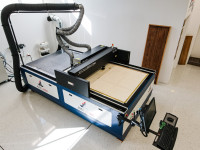Use of laser technology in lightweight construction
Efficiency and precision redefined
In recent decades, laser technology has established itself as one of the most versatile and precise technologies. In the field of lightweight construction in particular, the use of lasers opens up new possibilities for increasing efficiency, reducing weight and saving materials.
Lightweight construction is considered a key technology for numerous industries – from the automotive and aerospace industries to electrical engineering. The goal: to save resources and increase efficiency while ensuring mechanical stability. In this context, laser technology is becoming more and more important. Whether cutting, engraving or marking – the use of lasers is revolutionizing lightweight construction and offering numerous advantages.
What is lightweight construction?
Lightweight construction refers to the design philosophy in which the main objective is to minimize the weight of components and structures without compromising stability and strength. This is achieved by using lightweight materials such as aluminum, magnesium, titanium and modern composite materials. Lightweight construction is used in numerous industries, including the automotive, aerospace and construction industries.
Why is lightweight construction so important?
Lightweight construction is much more than just a trend. It is the answer to increasing demands for energy efficiency, sustainability and performance. In the automotive and aerospace industries in particular, the focus is on weight savings in order to reduce fuel consumption and emissions. Lightweight construction also plays a central role in electrical engineering, for example in the manufacture of batteries for electric vehicles. The lighter and more compact the components, the higher the efficiency.
Advantages of using laser technology in lightweight construction
Precision and accuracy
Laser technology enables extraordinary precision when processing materials. The focused and high-energy light beams allow even the finest cuts and engravings to be realized. This is particularly advantageous in lightweight construction, since precisely manufactured components improve the structural integrity and performance of the end products.
Material savings
Lasers enable material-friendly processing, as they generate minimal waste. The high cutting accuracy reduces waste and optimizes material consumption. There is no mechanical stress or thermal change that could weaken the material. This reduces costs and makes more efficient use of resources.
Flexibility and versatility
Lasers are able to process a wide range of materials, including metals, plastics and composites. This versatility makes them an ideal tool for lightweight construction, where different materials are often combined. In addition, lasers can be used for different processing steps, such as cutting, engraving and structuring.
Speed and efficiency
Laser processing is extremely fast and efficient. Compared to traditional processing methods, laser processes can significantly reduce production times. This leads to higher productivity and faster time to market for lightweight products.
Examples of laser technology applications in lightweight construction
Laser cutting processes
Laser cutting systems are frequently used in lightweight construction to produce precise and fast cuts in materials such as aluminum and composite materials. This technology enables the cutting of complex shapes and contours with high accuracy, which is particularly advantageous in the production of components for the automotive and aerospace industries. The ability to seamlessly cut various materials makes laser technology an indispensable tool in modern lightweight construction.
Laser engraving
Laser engraving is another important application of laser technology in lightweight construction. It enables the application of highly precise and permanent markings on various materials. This is particularly useful for labeling and ensuring the traceability of components. Whether logos, serial numbers or technical information, laser engraving ensures that the markings are clear and long-lasting without damaging the material. This technology is widely used in the automotive and aerospace industries, where the traceability and identification of components is crucial.
Future outlook
Laser technology will continue to play a key role in lightweight construction and drive the development of new and innovative applications. Advances in laser technology, such as the development of high-power lasers and the integration of automation and digital control systems, will further increase efficiency and precision. This will enable the production of even lighter and higher-performing components that meet the requirements of modern industries.
The use of laser technology in lightweight construction offers numerous advantages, including high precision, material savings, versatility and efficiency. The wide range of possible applications, from cutting and engraving processes to surface treatment and structuring applications, makes lasers an indispensable tool in modern manufacturing. The future of lightweight construction will be largely shaped by innovations and advances in the field of laser technology, which will help to develop ever lighter and more powerful products.


